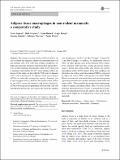Adipose tissue macrophages in non-rodent mammals: a comparative study
Author(s)
Ampem, Grace; Bacsadi, Árpád; Balogh, Lajos; Schmidt, Susanne; Thuróczy, Julianna; Röszer, Tamás; Azegrouz, Hind; ... Show more Show less
Download441_2015_Article_2253.pdf (6.237Mb)
PUBLISHER_POLICY
Publisher Policy
Article is made available in accordance with the publisher's policy and may be subject to US copyright law. Please refer to the publisher's site for terms of use.
Terms of use
Metadata
Show full item recordAbstract
The stromal vascular fraction (SVF) of adipose tissue in rodents and primates contains mesenchymal stem cells and immune cells. SVF cells have complex metabolic, immune and endocrine functions with biomedical impact. However, in other mammals, the amount of data on SVF stem cells is negligible and whether the SVF hosts immune cells is unknown. In this study, we show that the SVF is rich in immune cells, with a dominance of adipose tissue macrophages (ATMs) in cattle (Bos primigenius taurus), domestic goat (Capra aegagrus hircus), domestic sheep (Ovis aries), domestic cat (Felis catus) and domestic dog (Canis familiaris). ATMs of these species are granulated lysosome-rich cells with lamellipodial protrusions and express the lysosome markers acid phosphatase 5 (ACP-5) and Mac-3/Lamp-2. Using ACP-5 and Mac-3/Lamp-2 as markers, we additionally detected ATMs in other species, such as the domestic horse (Equus ferus caballus), wild boar (Sus scrofa) and red fox (Vulpes vulpes). Feline and canine ATMs also express the murine macrophage marker F4/80 antigen. In the lean condition, the alternative macrophage activation marker CD206 is expressed by feline and canine ATMs and arginase-1 by feline ATMs. Obesity is associated with interleukin-6 and interferon gamma expression and with overt tyrosine nitration in both feline and canine ATMs. This resembles the obesity-induced phenotype switch of murine and human ATMs. Thus, we show, for the first time, that the presence of ATMs is a general trait of mammals. The interaction between the adipose cells and SVF immune cells might be evolutionarily conserved among mammals.
Date issued
2015-08Department
Massachusetts Institute of Technology. Research Laboratory of ElectronicsJournal
Cell and Tissue Research
Publisher
Springer-Verlag
Citation
Ampem, Grace, Hind Azegrouz, Arpad Bacsadi, Lajos Balogh, Susanne Schmidt, Julianna Thuroczy, and Tamas Roszer. "Adipose tissue macrophages in non-rodent mammals: a comparative study." Cell and Tissue Research, vol. 363, no. 2, August 2015, pp. 461-478.
Version: Author's final manuscript
ISSN
0302-766X
1432-0878